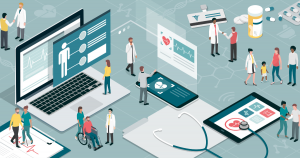Just how severe is physician burnout? A 2019 report by Medscape put it at approximately 44% –– nearly half of the more than 15,000 respondents across 29 specialties who have long-term, unresolved stress that often results in exhaustion, overwhelm, detachment, and lack of feeling personal accomplishment. What’s to blame?
There are several factors, but the primary contributors include having too many bureaucratic or administrative tasks (charting, paperwork, data entry, etc.), long hours spent at work, and increased time spent in electronic health records (EHRs). While documenting patient health information is not a novel concept in healthcare, many providers have pointed to enterprise EHRs as adding complexity to the process and thus extending their time at work.
While many providers believe EHR technology is squarely to blame for decreasing time spent with patients and increasing dissatisfaction with their career, there are ways to leverage existing technology to enhance the provider experience, reduce burnout and potentially improve the healthcare organization’s bottom line.
Burnout impacts the everyone in the healthcare equation
For every hour the average physician spends on direct patient care, they spend two hours on EHR data entry and other administrative work, according to a 2016 study of ambulatory care physicians. Stressful work environments, coupled with the fact that many physicians are not prepared for the amount of non-clinical burdens (i.e. billing, insurance, documentation) that will be placed on them, all contribute to physician burnout.
According to the Mayo Clinic, over 50% of physicians experience burnout and even higher burnout rates are seen in specialized areas. The emotional and physical fatigue faced by physicians also have adverse effects on the health system performance and the bottom line. As physicians experience exhaustion and loss of enthusiasm, they may distance themselves from their patients and the organization, which impacts the patient experience. As a result, healthcare organizations are also more likely to experience staffing turnover, increases in medical errors, and absenteeism, to name a few.
Though some EHR technology and data entry has become a pain point for many providers, the right technology can actually improve the provider experience. We know electronic health records and the emphasis on the shareability of that data aren’t going away, particularly as the industry pushes towards interoperability, and the use of technology in the clinical setting will only become more prevalent. But when that technology is tailored to the workflows of providers, it can alleviate the burden on them, help them deliver a better patient experience, and will prove an important piece in reducing burnout.
Tailored technology enhances the experience
There are many options for building a system that is more conducive to a less stressful work environment. One way is to begin with a physician-centered EHR by shadowing physicians or using analytical tools to monitor what areas of the platform are most used and which are ignored then using this insight to creating a more personalized experience. In some cases, simply removing unnecessary buttons and alerts can drastically improve physician workflow.
A purpose-built EHR that takes the physician’s needs into account can decrease the time spent on data entry which in turn allows for their time to be spent with patients as opposed to computers. In some cases, including physicians and caregivers in the technology selection and development process can help improve tech adoption and onboarding. Not to mention, involving them will help select or build a solution that better matches their workflow and addresses their needs. Increasing the time spent to train and onboard can also help improve satisfaction.
Streamlined data entry will be the future
Streamlining data entry is a crucial component to providing a better physician experience. Currently, physicians are spending nearly half their time on desktop medicine tasks, according to a Health Affairs study by the Palo Alto Medical Foundation. By giving physicians choices for note taking, such as voice recognition software, templates, remote scribe technology, or a combination of the aforementioned, it can help alleviate some of the administrative tasks that take them away from time with their patients.
In fact, according to Medical Futurist, companies such as IBM are at the cutting edge of streamlining data entry by building a cognitive assistant through the launch of an algorithm called Medical Sieve. Efforts are being made by Augmedix as well, through the use of Google Glass, they are providing a documentation service that allows for medical notes to be generated in real time without physicians having to log into computers during patient consults. The use of voice assistants is an endeavor launched by companies such as Nuance and M*Modal which offer dictation services. In addition, tech company, Notable has created a wearable voice powered-assistant that records data during patient interactions.
These tools are alleviating the data-entry burden from physicians, and bringing greater accuracy and real-time data to the care equation, but the challenge is, this data has to be able to flow to the EHR or health IT system. Many legacy systems weren’t built with data exchange in mind, and this is where cloud-based systems can become a tremendous asset.
Making data mobile
Today’s EHRs must be able to integrate with critical systems like virtual assistants, patient relationship management platforms, other EHRs, and APIs to support the accessibility of that data and place everything in one centralized hub. Through this integration, practitioners will be able to obtain information when they need it, and quickly.
Cloud-based systems are one way to achieve this. Cloud-based document management and workflow automation technology will ensure practitioners have access to data when and where they need it, and can make updates on the go from a variety of devices. This will enable better communication across the care team and help reduce duplication of data.
Successful integration and personalization of EHRs can be the key to better outcomes for physicians and hospitals. According to experts like Dr. Kathleen Harder, director of the Center for Design in Health at the University of Minnesota, building a physician-centered EHR will contribute to user friendly platforms, effective workflow, error reduction, and overall physician career satisfaction.








